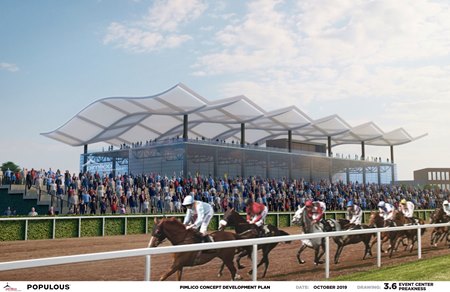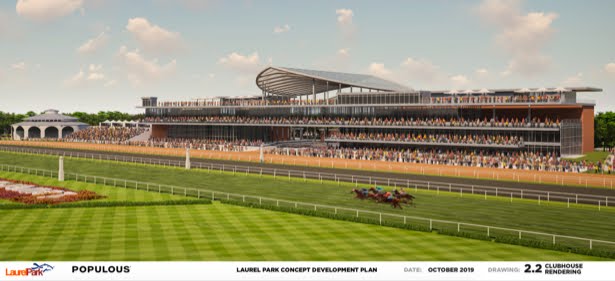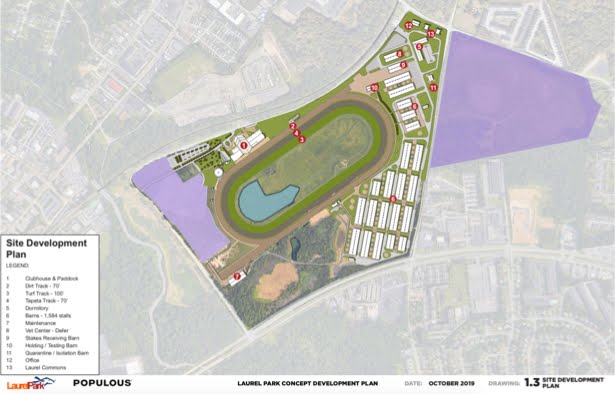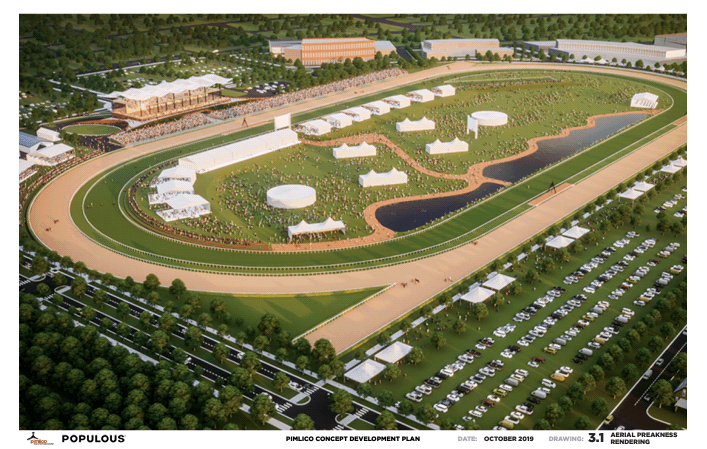
Pimlico Concept
With a possible early adjournment for the 2020 session coming Wednesday, March 18, due to the COVID-19 Pandemic, the Maryland House of Representatives worked all weekend. On Sunday, after amendments, members passed House Bill 1056 — the Racing and Community Development Act — by a majority vote of 122 to 130.
The Senate version of the bill (SB 987) sailed through March 6 with a near unanimous vote of 44 to 1. The differences between the two bills will be worked out between the House and Senate before going to the Governor’s desk.
Mainly, the language regarding Bowie Training Facility is at issue. Under the Senate version of the bill, Bowie would be turned over to the Maryland-National Capital Park and Planning Commission and the City of Bowie for use as sports fields and parkland. The House of Delegates version of the bill creates a task force to study the future of the Bowie Training Center property. Another consideration raised regarding the future of the Bowie property is whether the Maryland Jockey Club (MJC) may need to temporarily use the training center during rebuilding of Laurel.
Laurel Park Goes First
For Laurel, The Stronach Group (TSG) would enter into a ground-lease arrangement with Anne Arundel County or a county-designated entity that would run for at least 30 years. The company would have the option of regaining full ownership of the property at the end of the lease.
Total Project Costs = $173,365,000:
+ Demolition, Infrastructure, Site Work = $47,917,000
+ Barns, Training, Backstretch = $57,270,000
+Clubhouse and Paddock = $68,178,000
Renovated first, Laurel would continue to be the focus of year-round racing in Maryland. Laurel will function as a supertrack and year-round training facility with a Tapeta track added between the turf and dirt tracks, a new modern clubhouse and all new barns and backstretch. The iconic Laurel paddock will be saved and repurposed.
While Laurel is renovated from 2021 to 2023, horses, horsemen and workers will be moved to Pimlico and all racing would be held there.
Pimlico’s Turn and The Preakness Is Still Running
TSG would turn Pimlico over to Baltimore City or a city-approved entity such as the Maryland Stadium Authority.
Total Project Costs = $199,547,000:
+ Demolition, Infrastructure, Site Work = $101,302,000
+ Tracks, Infield, Community Spaces = $33,099,000
+ Multi-purpose Clubhouse and Events Center = $65,146,000
Then Pimlico gets a complete overhaul in 2023 and 2024 with the Preakness being held there during construction. Instead of a racing-focused facility, Pimlico would be renovated into a multiuse facility that would be used most of the year for youth sports, festivals and other events.
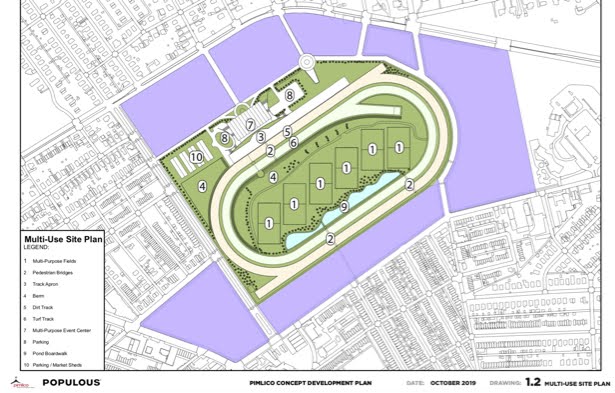
Pimlico’s expansive physical plant, including the clubhouse built in 1959 and backstretch, will be leveled replaced with a small glass multi-purpose clubhouse surrounded by commercial development on approximately 50% of the property. The racing oval dirt and turf tracks will be rotated and shortened to 15/16th of a mile with two chutes. The infield will be replaced with berms, a pond and footbridge and athletic fields.
The facility will cease to operate as a year-round training facility, will have no barns or dorm quarters on the backstretch. Ship in temporary stables and accommodations will be constructed for the Preakness meet.
The first Preakness at the rebuilt Pimlico would be held in May 2024, Preakness 149. The Maryland Jockey Club would enter into a 30-year agreement to lease Pimlico to run a spring meet including the Preakness Stakes. MJC would pay an estimated $10 million per year to build temporary stands, tents and customer accommodations for the Preakness.
According to plans released in October 2019, the new clubhouse would not have fixed seating and would be a hospitality area for guests in reserve grandstand seats. For the Preakness capacity is estimated at 51,500 including various suite and reserved seating options trackside and turfside including accommodations for 8,000 in an infield picnic area, 12,000 reserved seats along the home stretch and 20,000 general admission tickets for access to the infield.
Odds and Ends
The proposal would entail the creation of several new government agencies to manage the properties and construction. The Stronach Group, operating as the Maryland Jockey Club, would receive a license to operate racing at the two tracks contingent upon adhering to current state laws and regulations. MJC would be required to have at least 180 racing days each year, between Laurel and Pimlico.
The Funding
TSG is seeking $389 million for rebuilding both facilities. The legislation would allow up to $375 million worth of bonds to be issued for the projects, though racing officials believe they may need to use only about $348 million in bonds.
The Maryland Stadium Authority would borrow money upfront to pay for most of the work, in the form of bonds that would be sold on the market. Those bonds would be paid back over 30 years using $17 million per year from the Maryland Lottery.
The lottery would be replenished from three sources:
– $5 million annually in money from slot money from the Purse Dedication Account (PDA) referred to as the “horsemen’s contribution.”
– $3.5 million annually in slots money that had been going to community aid in Baltimore.
– $8.5 million annually from the slots-funded Racetrack Facility Renewal Account (RFRA), money that had been set aside for facility capital improvements (due to sunset in 2035).
– The project also would use about $24 million that will be built up and sitting in the Racetrack Facility Renewal Account by March 2021 and $17 million in a one-time payout from the Maryland lottery.
Under Maryland law, the state’s horsemen receive subsidies from slots to supplement purses (PDA), while The Stronach Group receives grants from slots revenues to fund capital improvements (RFRA), as long as plans are submitted beforehand, all terms and deadlines are met and those funds are matched by the company. The proposal would allow those subsidies to be used to underwrite the bonds, which would have a 30-year maturation. That would require a change in existing state law, which guarantees the slots subsidies through the end of 2035, covering less than half of the 30-year term of the proposed bond.
The plan also calls for a break on the sales tax for construction equipment and other materials that will be used in redeveloping of both facilities. Lawmakers have approved a similar sales tax exemption for other large projects in the state.
The Final Process
If the plan passes the General Assembly, it would go to Gov. Larry Hogan, who could sign the bill, veto it or allow it to become law without his signature. Hogan has expressed interest in keeping the Preakness Stakes in Baltimore but has not offered a position on the bill.
If signed into law, The Stronach Group, now branding as 1/ST, will sign a 30-year agreement to operate both facilities with an option to repurchase the properties once the bonds are paid off. TSG will retain ownership of the Maryland Jockey Club (MJC), under which the facilities will be operated, the Preakness Stakes and the Woodlawn Vase.
Image: Aerial site rendering of Pimlico set up for Preakness by Populus from plan proposal.



